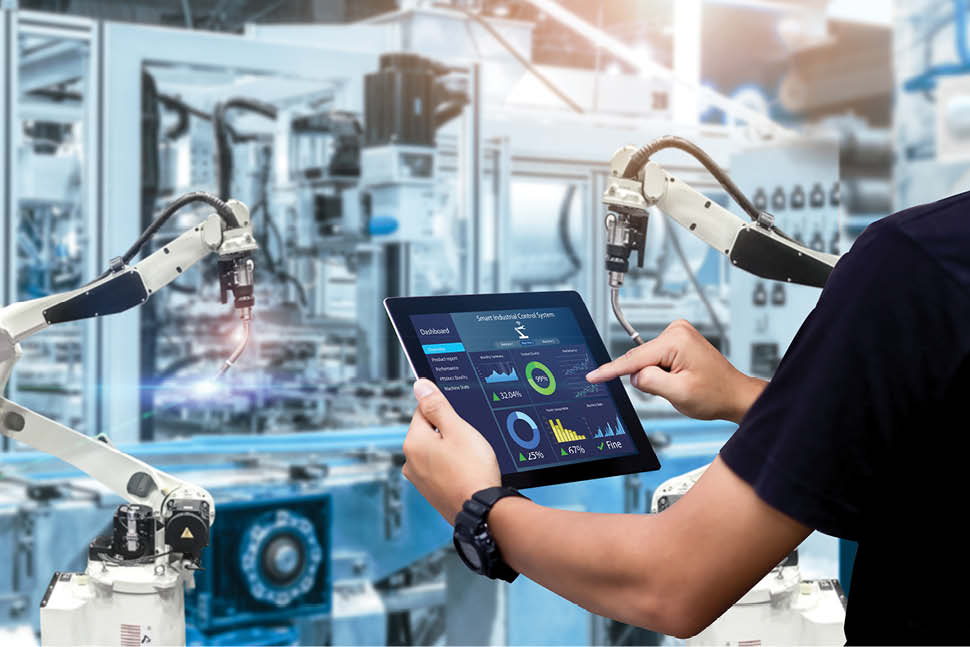
June 2022 / Vol. 27 No. 6
by Jesse Henson, President, NEMA Motors, ABB
From linking dislocated supply chains to ensuring efficiency as employees work remotely, manufacturers have had to rethink their strategies to bring their businesses back to capacity after COVID-19.
In this new reality, companies are building resilient yet flexible manufacturing processes to improvise the fundamentals of their business, including shifting supply chains to new geographies without high risk or developing new product mixes in a high-cost environment. Concepts such as digitalization and automation promise to help businesses thrive in the new industrial landscape.
Boost Efficiency with Automation
Businesses are increasingly looking at ways to automate their operations to enhance productivity and efficiency and mitigate the challenges of a lack of skilled labor. Automation, especially with robots, has helped manufacturers continue their work while keeping their human employees safe.
The evolution of robotic automation has moved toward making robots more accessible to small and medium-sized companies. Workers can easily program smaller-sized collaborative robots without specialized training, and install them on existing production lines. The small robots are less expensive than larger industrial robots, making them ideal for small-scale and family-owned businesses. These robots can work alongside and with human operators and boost productivity and flexibility in processes such as palletizing and small parts assembly. The absence of safety fences and large peripheral equipment also means that the investment needed for a robotic work cell can go from more than $200,000 to under $50,000. Manufacturers can rely on robotics to provide the necessary boost to production.
Digital Continues to be the Next Normal
The digitalization of industrial processes and the adoption of Industry 4.0 concepts, including automation, advanced analytics, and digital connectivity, have been well underway in many organizations across the world. Digitalization enables companies to capitalize on the benefits of digital tools, including sensors, cloud computing, and the internet, to add value to existing processes. In manufacturing, which is based on testing physical prototypes using a vast amount of seemingly disparate data, digitalization can provide actionable insights that, in turn, help manufacturers find the best ways to manufacture new products and reduce the time it takes to bring them to market.
In today’s reality, digitalization has moved from being a long-term strategy to a much-needed remedy to increase the reliability and efficiency of the manufacturing process. Digital simulations of factory concepts, new products, and processes can iron out issues virtually before manufacturers make any physical investment, while digital twin technology can provide clarity and transparency in increasingly complex manufacturing environments.
Digitalization does not have to be a time-consuming upgrade, nor does it always require significant investment. Even small, family-owned businesses can easily integrate digitalization technologies to boost productivity, reduce downtime, and eventually save money by mitigating unplanned downtime.
Gaining transparency across the factory floor is another benefit that digitalization offers manufacturers. This is especially useful for companies developing new products, implementing new processes, or working with new technologies. Simple monitoring solutions can add value to manufacturing by giving operators the ability to move from a time-based maintenance approach to a condition-based one, thereby reducing the chances of unscheduled stoppages.
Remote service has become a buzzword in the current manufacturing environment, as it provides quick and easy solutions to an otherwise time-consuming process. With monitoring services, companies can track the health of their assets and maximize their performance with little interruption to operations. The monitoring is provided remotely, enabling a company to perform remedial actions and improve product health without stepping on-site. This ultimately boosts the efficiency and productivity of the operation and leads to better savings.
Expand Reality for Better Results
As the rules of manufacturing change, maintaining business continuity and ensuring the smooth operation of assets are at the top of the agenda for companies across the world. Companies are increasingly turning to digital solutions to access their operations and perform simplified, restorative maintenance to keep their processes running smoothly.
One way to address this issue is by using augmented reality (AR) technology to connect field personnel to remote professionals offering diagnostic and repair guidance. For example, ABB piloted an AR service at ArjoWiggins Creative Papers in Scotland and Papierfabrik Adolf Jass in Germany two years ago. Headsets augmented with maintenance strategies, documentation, guidance, access to expertise, and other best practices were given to employees on-site. Field operatives streamed live video of asset conditions at the site to remote experts, who, in turn, delivered live audio instruction, overlaid onto video to help them resolve issues quickly.
In the manufacturing world, adversity has often been the spark for innovation, and this time around, manufacturers have had to take bold decisions to ensure that they remain ahead of the game. Integrating the right digital and automation strategies was a step in this direction.
ei